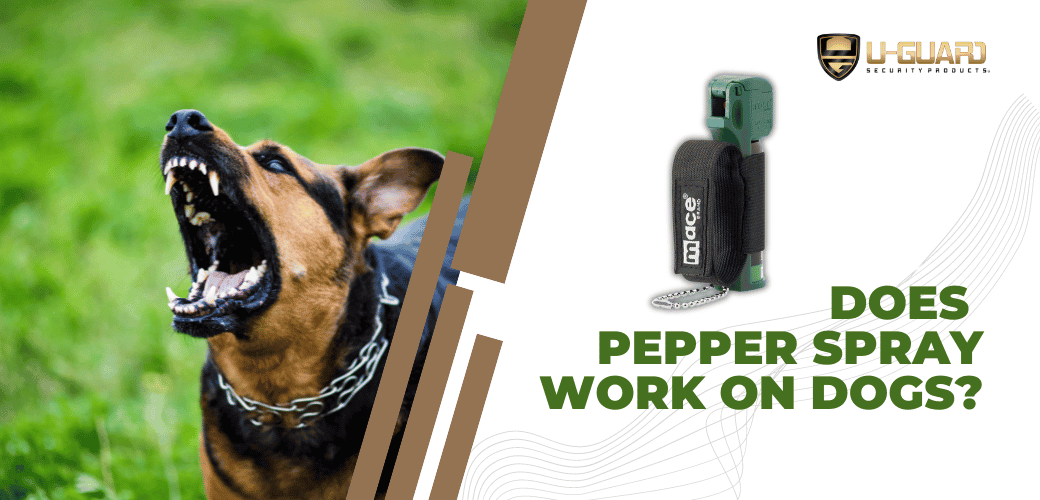When faced with a potentially dangerous situation involving a dog, many people wonder, “Does pepper spray work on dogs?” Pepper spray is commonly used as a self-defense tool against human attackers, but can it be just as effective on our furry friends? In this article, we will explore the effectiveness of pepper spray on dogs, its safety considerations, and the legal implications of using it in such situations.
Is Canine Pepper Spray Effective on Dogs?
Canine pepper spray is engineered with the intent to provide a non-lethal but effective solution for deterring aggressive canine behavior. Its formulation, while similar in basis to that of human pepper spray, is tailored to the sensitivity levels of dogs, ensuring that it works efficiently across the vast array of dog breeds and sizes. This specialized design takes into account the physiological and behavioral differences between dogs and humans, aiming to create a temporary, discomforting effect that is strong enough to stop an attack or aggressive behavior without causing permanent harm to the animal.
The effectiveness of canine pepper spray hinges on the correct application and situation. It works by irritating the mucous membranes in the eyes, nose, mouth, and lungs, leading to a temporary incapacitation that can give a person enough time to retreat to safety. The degree of effectiveness can vary depending on factors such as the distance at which it is applied, wind conditions, and the aggressiveness or determination of the dog.
Because the product is designed for use on dogs specifically, it incorporates a balance that seeks to maximize effectiveness while minimizing potential harm. This careful formulation ensures that it can be used on dogs of all sizes, from smaller breeds to larger, more powerful ones. Despite this, it’s important for users to understand that, like any defensive tool, canine pepper spray is not a guaranteed solution in every situation and should be used as part of a broader approach to safety when dealing with aggressive dogs. Proper training on the use and limitations of canine pepper spray can enhance its effectiveness and ensure it serves its intended purpose as a humane method of self-defense.
Is it Safe to Pepper Spray a Dog?
Using pepper spray on a dog carries with it a responsibility towards ensuring the safety and welfare of the animal, even in the midst of defending oneself. The intent behind the application of pepper spray is to momentarily disorient or deter an aggressive dog, not to cause long-lasting harm. The compounds found in canine-specific pepper spray are designed to induce temporary discomfort, which can include a burning sensation in the eyes and respiratory distress, giving a person the chance to escape a potentially dangerous encounter.
However, the degree of safety associated with using pepper spray on a dog greatly depends on the manner in which it is used. Direct, close-range application, especially to sensitive areas like the eyes or nose, should be avoided to reduce the risk of causing intense pain or potential injury. While the effects are largely temporary, the distress experienced by the animal can be profound. Consequently, it is imperative to consider alternate methods of de-escalation or deterrents when faced with an aggressive dog.
Training on the proper use of pepper spray is essential for those who choose to carry it for self-defense purposes. Understanding how to effectively deploy the spray while minimizing harm to the animal is crucial. In situations where the use of pepper spray becomes necessary, it is also critical to monitor the affected dog afterward, if possible, and report the incident to local animal control or veterinary professionals to ensure the animal receives any needed care.
In essence, while canine-specific pepper spray is formulated to be a safer option for use on dogs compared to human-grade pepper sprays, its use still requires a judicious, informed approach to ensure it serves as a humane and effective method of self-defense without compromising the safety and well-being of the animal.
Canine vs. Human Pepper Spray: Understanding the Difference
The distinction between canine and human pepper spray lies primarily in their formulation. While both types of spray utilize capsaicin, the compound that gives chili peppers their heat, the concentration and blend are adjusted in canine sprays to cater specifically to the sensitivity of dogs. This modification is crucial, as dogs possess a more acute sense of smell and could react differently to the same concentrations used in sprays intended for humans. Additionally, the spray mechanisms and delivery systems may differ to ensure that the spray can be used effectively and safely at a distance suitable for deterring an aggressive dog without causing undue harm.
Manufacturers of canine pepper spray often conduct extensive research to determine an effective yet safe formulation. This includes considerations for the animal’s health, potential for temporary discomfort versus long-term harm, and the immediate effectiveness needed to stop aggressive behavior without exacerbating the situation. Unlike human pepper spray, which is designed to incapacitate a human assailant and may have a stronger concentration or different spray pattern, dog pepper sprays aim to create a deterrent effect that gives the user time to move away from the threat.
It’s worth noting that while the base ingredient is similar across both types of sprays, relying on a human pepper spray as a defense against dogs is not advisable due to these formulation differences. The increased concentration in human sprays could potentially cause more severe distress or injury to a dog, which is counter to the goal of temporarily deterring the animal without causing lasting harm. Understanding these differences is essential for choosing the appropriate defense tool in situations involving aggressive canine behavior.
Brands Offering Dog-Specific Pepper Sprays
Navigating the market for dog-specific pepper sprays, one will encounter a handful of brands that specialize in products engineered to safely and effectively deter aggressive dog behavior. Among the most recognized names in this niche are Halt!, Mace Animal Repellent , and Sabre Dog Spray. Each of these brands has conducted extensive research and development to formulate sprays that balance efficacy in stopping an attacking dog with the need to minimize potential harm to the animal. Halt! has been a go-to option for postal workers and delivery personnel for years, providing a reliable defense against canine threats. Most pepper spray for human use, on the other hand, offer products that not only focus on stopping aggressive behavior but also on user safety, featuring sprays with UV dye to mark the aggressor. Sabre Dog Spray is known for its maximum strength formula that is still safe for the dog, designed to provide protection at a safe distance. These brands, among others, have dedicated themselves to creating options that allow individuals to protect themselves while also considering the welfare of potentially aggressive dogs. When selecting a pepper spray for dogs, it is crucial to consider factors such as range, potency, and safety features to ensure that the product meets the user’s needs without causing unnecessary distress to the animal.
Effectiveness Against Rabid Dogs: A Closer Look
Addressing the concern of whether pepper spray is effective against rabid dogs, it’s crucial to understand the heightened risks involved. Dogs infected with rabies often display erratic behavior, including increased aggression and diminished response to external stimuli. This altered state can impact the efficacy of deterrents like pepper spray, as the disease affects the animal’s neurological system, potentially making them less responsive to the discomfort it causes.
When dealing with a dog suspected of having rabies, the primary goal should always be to maintain a safe distance and avoid engagement whenever possible. In situations where an encounter becomes unavoidable, pepper spray may serve as a temporary measure to halt an attack, allowing for an opportunity to escape and seek safety. However, its effectiveness should not be solely relied upon due to the unpredictable nature of rabid animals.
The urgency of these encounters necessitates an immediate response following any use of pepper spray — not just for the safety of the individual but also to address the health crisis posed by a rabid animal. Contacting local animal control and health departments immediately after such an incident is imperative to manage the threat effectively.
Additionally, it’s worth noting that in the face of a rabies threat, the safety of the individual must be prioritized. While the use of pepper spray on animals should always be considered carefully, the potential for rabies transmission elevates the situation to a public health concern. In these instances, the application of pepper spray, if needed to prevent an attack, is a part of broader measures to protect human life against a deadly disease. Following any encounter with a potentially rabid dog, seeking medical evaluation is crucial due to the severe consequences of rabies exposure.
Defending Yourself Humanely with Pepper Spray
When confronted with an aggressive dog, the use of pepper spray should be approached with caution and considered only after all non-confrontational strategies have been exhausted. It’s imperative to remember that the primary aim is to create a safe escape route without causing unnecessary harm to the animal. In instances where pepper spray becomes a necessary measure, its application must be precise and controlled. Aim to deploy the spray as a barrier between you and the dog, rather than a direct attack on the animal. This method can help to deter the dog’s advance and provide you the opportunity to retreat safely.
Understanding the mechanics of your pepper spray device beforehand is crucial. Familiarize yourself with its range, spray pattern, and how to unlock it swiftly in an emergency. This knowledge will aid in using the spray effectively, minimizing the risk of misuse or accidental harm.
In addition, always carry your pepper spray in an accessible location, but ensure it is secure and won’t accidentally discharge. In the heat of the moment, fumbling for your spray could result in precious lost seconds.
Once in a safe location, report the incident to local animal control authorities, providing them with as much information as possible about the dog and the encounter. This step is vital not only for your safety but potentially for the welfare of the dog as well. An aggressive dog may be lost, scared, or in need of medical attention, and reporting the incident can lead to a resolution that benefits the community and the animal.
Adopting a proactive stance on learning nonviolent de-escalation techniques for dog encounters is also beneficial. These skills can serve as your first line of defense, reserving pepper spray as a final measure for self-protection.
Legal Considerations When Using Pepper Spray on Animals
Before deploying pepper spray in an encounter with an aggressive dog, it is crucial to be well-versed in the legal landscape surrounding such actions. The legality of using self-defense tools, including pepper spray, against animals varies significantly from one jurisdiction to another. Some regions may have specific statutes or ordinances that directly address the use of deterrents against animals, while others may encompass such actions under broader self-defense or animal welfare laws.
In many areas, using pepper spray on a dog is legally permissible when it is done strictly in self-defense and when there is a genuine threat to personal safety. However, the action must typically be justifiable under the circumstances, with a clear and immediate threat present. Arbitrary or preemptive use against animals without an imminent threat could lead to allegations of animal cruelty or abuse, carrying potential legal repercussions.
To navigate these legal waters safely, individuals should conduct thorough research or consult legal advice to understand the specific regulations in their locality. This diligence is especially important because, in the aftermath of using pepper spray on a dog, one may be required to provide evidence or testimony justifying the act as a necessary measure of self-defense.
Additionally, if an incident involving pepper spray and a dog occurs, it may be mandatory to report it to local authorities or animal control agencies. Such reporting can be critical in cases where the animal might require medical attention or in instances where there is a risk of rabies or other diseases.
Ultimately, while the primary goal is personal safety, ensuring that one’s actions remain within the bounds of the law is essential to avoid unintended legal complications. Being informed and prepared can make all the difference in handling these challenging situations appropriately.





